In this post, we’ll define leeway, show you how to become aware of your boat’s leeway, and share tips on how to improve your upwind performance by managing and minimizing leeway.
You can watch the video or read the summary below.
Video: Understanding Leeway
Definition
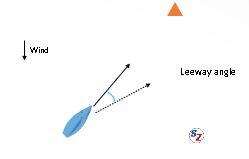
Leeway is the distance (or angle) a boat drifts off course to leeward due to the sideways force of the wind. Notice the boat ‘s bow is pointing toward the mark but the boat is slipping to leeward. This is because the wind is pushing the boat sideways. The angle between the boat’s heading and its actual track through the water is called the leeway angle.
Why do we have to put up with Leeway?
Leeway is always present unless you are sailing directly downwind. Let’s understand why in more detail.
The wind creates lift, which pushes the boat forward and to the leeward side.
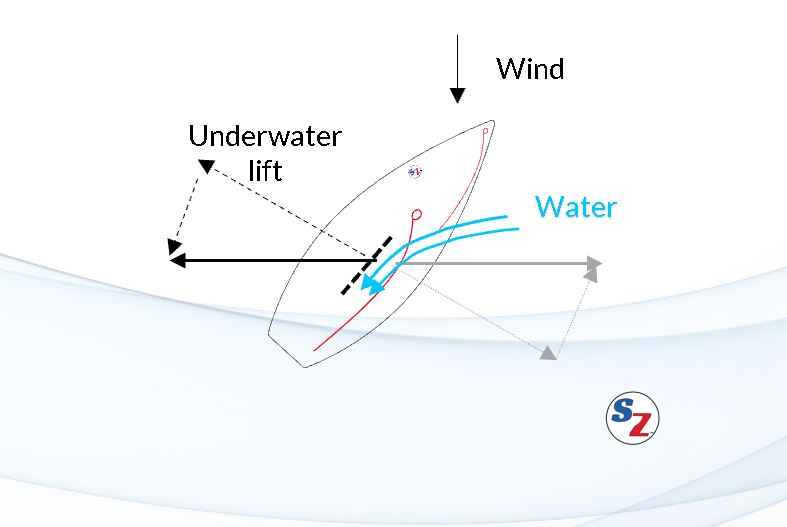
The forward and leeward motion creates lift and drag on the boat’s underwater surfaces (hull, boards, rudder), generating lift and drag.
The underwater lift reduces the slippage to leeward. However it can’t totally stop the slippage, because it needs some slippage to create lift.
The amount of leeway depends on how much lift the underwater surfaces generate.
Observing Leeway
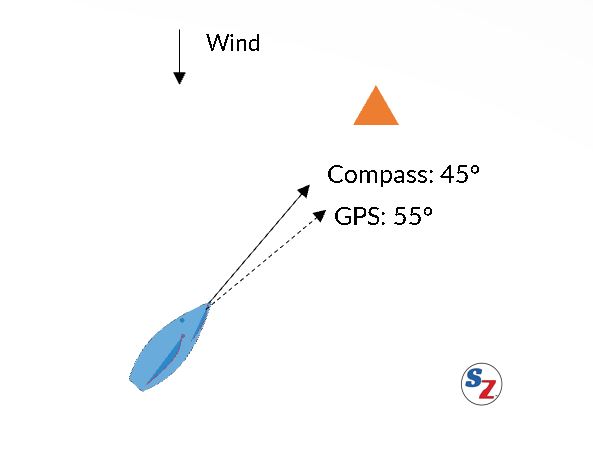
You should try to be sensitive to the amount of leeway your boat is experiencing. Normally, it’s not too noticeable, but you still should be aware of it, especially if it increases.
The easiest way to observe is to use a course mark or point on shore. If the bow is pointed towards the mark, you’ll soon see that your actual progress is taking you lower than the mark.
If your boat has instruments, you can measure your leeway by comparing your compass heading to a GPS-based bearing that measures your actual track through the water. In the case shown, what is the leeway angle? The answer is 10 degrees, which is the difference between the boat’s heading and its actual track through the water.
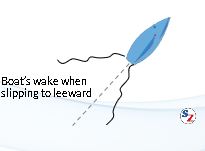
If you’re making a lot of leeway, you can see it by watching the wake off your stern. As the boat slips to leeward, the windward side wake is at a greater angle to the boat than the leeward side wake.
We can see leeway in the video of an X boat sailing on a windy, puffy day. Watch for indications that the boats is side-slipping, including the shore reference and the boat’s wake. Watch what happens when the boat heels up.
What factors affect leeway?

Most racing boats sail upwind in medium breeze with 3-5 degrees of leeway. The drawing shows a 5 degree leeway angle, which is pretty hard to see on the water. However, there are times when leeway increases and you should know the factors that cause it to increase.
- Boat speed. As the boat slows, there is less flow over the foils, and therefore less lift. The term foils includes the centerboard, leeboards, and rudder.
- Angle of heel. The foils are less effective when they are not vertical in the water.
- Waves or other pitching and rolling. If the boat pitches and rolls or the angle of heel isn’t constant, this disturbs the flow over the foils, which reduces lift.
- Poorly shaped foils. Some boats have foils are flat plates instead of being curved on both sides like a wing. Flat plates increase leeway will Increase. Just like airplane wings, curved surfaces generate more lift.
- Foil surfaces are not smooth. A rough surface generates turbulent flow and reduces lift to counteract leeway. So make sure your boards are clean and smooth.
- Mainsail is over-trimmed. An over-trimmed sail generates more side force increasing leeway.
Common Problems and Tips
Misjudging the layline
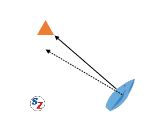
The most obvious problem is judging the layline. As the diagram shows, you have to go a little past the layline to account for leeway, or else you won’t be able to sail to the mark.
This becomes more difficult, the further away you are from the mark. That’s one of several reasons for avoiding the lay lines until you’re close to the mark.
You also have to worry about factors that could slow you down and increase leeway, such as disturbed air, or a decrease in wind strength. Also wind shifts will affect the layline, though shifts do not affect leeway directly.
Too much leeway
Too much leeway is another common problem. This is often the case just after the start, when your boat is not moving fast, or in light air when you’re not trimming properly. Here are some clues:
- First, the boat will feel slow. Remember, lack of speed makes leeway increase.
- A very frustrating sign is that boats that are sailing at the same heading are gaining to windward, even if they are in the same wind as your boat.
- You can also look at your telltales for a third clue. Often, if you’re going slow, the telltales on your stays will be pointing into the front of the sail rather than towards the aft portion of the sail. Another way of saying this is that your apparent wind is further aft than normal.
To reduce leeway you need to build speed and and you may also need to reduce side force.
- First, match your sail trim and heading to the apparent wind to get air flowing over the sails and build speed. This may mean easing the sheets or heading up if you’re over trimmed, or trimming in or heading down if you’re under trimmed. Do whatever it takes to build speed as soon as possible. Don’t worry abut the other boat’s heading until after you build speed.
- If you’re overpowered, you have to reduce the side force. Assuming you’re already hiking hard, you have to reduce power, either by flattening the sails with your controls – vang, cunningham, and outhaul – or by easing the sail momentarily to let it luff and spill power.
- Once you’ve built speed and your apparent wind starts moving forward (telltales point more to rear of sail) you can head up and your leeway will be back to normal.
Bonus Content: Rudder Angle and Leeway
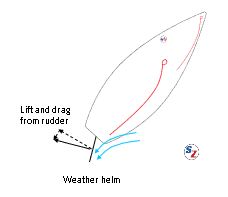
If you want to dig into the topic more deeply, here’s some more detail about how the rudder angle affects leeway.
The rudder also provides underwater lift to combat leeway. It also provides unwelcome drag. This is true even if the rudder is centered.
If your boat has weather helm, you have to pull the tiller slightly to windward to keep it sailing straight. Your rudder will feel extra pressure from the water flowing past it. This produces additional underwater lift and drag.
Some experts claim that a small amount of weather helm improves overall performance. There’s a sailing world article by Andy Horton that claims your leeway angle plus your rudder angle should add up to 5-7 degrees for best upwind performance. He recommends experimenting with boat tuning to find the best combination of leeway and weather helm.
I found data in the Buccaneer 18 tuning guide claiming to prove that three degrees of weather helm (rudder angle) improves upwind performance in winds up to 13 knots. Above 13 knots there is no advantage to weather helm.
On the other hand, several respected experts (Dave Ullman, Mike Ingham, Greg Fisher) firmly believe that a neutral helm gives the best upwind performance. They would say that the only reason for a slight weather helm is to help the skipper feel if the boat is powered up.
Whichever set of experts is correct doesn’t make that much difference. All experts agree that more than a few degrees of weather helm slows you down. Getting the other stuff right is more important.
SailZing Sail Trim Series – effects of sail trim on side forces.

